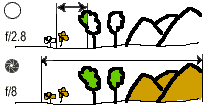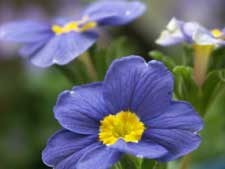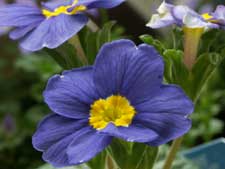What Is... Aperture?
When you look at the technical specifications of a digital camera, one of the very first specification mentioned is its maximum aperture and/or its aperture range.
What is 'aperture,' what is a good aperture range, and how is aperture relevant when it comes to choosing a digital camera?
What Is Aperture?
The main function of a camera lens is to collect light. The aperture of a lens is the diameter of the lens opening and is usually controlled by an iris.The larger the diameter of the aperture, the more light reaches the film / image sensor.
Aperture is expressed as F-stop, e.g. F2.8 or f/2.8. The smaller the F-stop number (or f/value), the larger the lens opening (aperture).
[Note: Many camera user manuals today will refer to the aperture in terms of "aperture value" instead of f/value. I'm not sure when this trend started but don't get confused between "aperture" and "aperture value." Aperture value" is simply another way of saying f/value.]
In practice, unless you are dealing with a fixed-aperture lens (many simple point-and-shoot cameras have only one fixed aperture), the aperture of a lens is usually expressed as a range of fstops.
When you read the specifications of a camera, the aperture may be expressed in a number of different ways, the following three being the most common:
- Maximum Aperture:
| F2.8 |
This simply states that the maximum aperture for the lens is F2.8.
- Aperture Range:
| F2.8-F8.0 |
This states the max. and min. aperture, the assumption being that there are standard increments between them.
- Maximum Wide-Angle and Telephoto Apertures:
| F2.8-3.5 or F2.8(W)-F3.5(T) |
This gives the max. aperture for the wide-angle (F2.8) and telephoto (F3.5) focal lengths of a zoom lens.
It is usually not too difficult to figure out that a stated range deals with maximum apertures and not max and min apertures: the mimimum aperture should be quite small at F8, F11, F16 or F22.
A "fast" lens is one that has a large maximum aperture (F2.4, F2.0 for current digital cameras; F1.4, F1.2 for 35mm film cameras).
Quick Quiz: which lens has a larger opening (aperture): one with an aperture of F1.8 or one with an aperture of F2.8?
Answer: F1.8 (remember, the smaller the F-stop, the larger the aperture)
A Good Aperture Range
My personal preference for a 'good' aperture range is:
F1.8 - F16
| F1.8 | F2.8 | F4 | F5.6 | F8 | F11 | F16 |
This tells us that the camera has an aperture range of F1.8 to F16; the maximum aperture is F1.8, and the minimum aperture is F16.
There are 5 f-stops between the max and min aperture. If your camera's lens is currently set at an aperture of F5.6, closing it by 1 f-stop would mean selecting F8; opening it up by 1 f-stop would mean selecting F4.
| F1.8 | F2.8 | F4 | F5.6 | F8 | F11 | F16 |
How Is A Large Maximum Aperture Relevant?
A large maximum aperture is preferable to a smaller one since it gives the photographer more latitude in the kind of pictures that can be taken.
For example, it is pretty obvious that the larger the aperture, the better your digital camera will perform in low-light situations, since a larger lens opening is able to admit more light than a smaller lens opening.
A larger max. aperture also allows you to use a faster shutter speed to freeze action.
So, let's say the light meter in your digital camera calculates that for proper exposure in that indoor arena, you need an aperture of F4 and a shutter speed of 1/60 sec.
| F4 |
| 1/60 |
To use a faster shutter speed (say, 1/250 sec.) to freeze action, you have to open up the aperture to allow more light in for that shorter amount of time.
For every shutter speed increment we go up, we need to open up a f-stop of aperture. From 1/60 sec. to 1/250 sec. there are 2 increments, so we open up the aperture by 2 f-stops, going from F4 to F1.8. Note that the camera would give proper exposure at 1/60 sec. at F4, 1/125 sec. at F2.8, and 1/250 sec. at F1.8, since all three aperture/shutter speed combinations allow the same amount of light into the camera. [Some digital cameras provide a 'Program Shift' function to allow that very shifting of aperture/shutter speed combinations in tandem.]
| F1.8 | F2.8 | F4 | F5.6 | F8 | F11 | F16 |
| 1/250 | 1/125 | 1/60 | 1/30 | 1/15 | 1/8 | 1/4 |
Of course, in a digital camera set on Auto mode, you can select Sports scene mode, and the camera will automotically select a fast shutter speed and the appropriate aperture. Likewise, in Shutter-Priority mode, you can choose which shutter speed you want (fast or slow), and the camera will select the appropriate aperture for proper exposure.
In our example above, let's say the lens on your digital camera only opens up to a max. aperture of F2.8. If you now select 1/250 sec. (in Shutter-Priority mode), the camera will not be able to select an aperture larger than F2.8 (in our example, it really needs F1.8). It would then give you an "underexposure" warning. If you go ahead and take the picture anyway, your picture would be 1 f-stop underexposed (i.e. you really needed to open up the aperture by 1 more f-stop for correct exposure).
Similarly, if you select a shutter speed of 1/4 sec. and the lens only closes down to a min. aperture of F8 (in our example, it really needs F16), the camera would give you an "overexposure" warning. If you go ahead and take a picture anyway, your picture would be 2 f-stops overexposed (i.e. you really needed to close down the aperture by 2 more f-stops for correct exposure).
[Editor's note: There is a third variable in the above example which we have purposefully not introduced. This is the sensitivity of the image sensor -- the ISO. We'll cover this in a later tutorial.]
How Is A Small Minimum Aperture Relevant?
A small minimum aperture is preferable to a larger one since it also gives the photographer more latitude in the kind of pictures that can be taken.
Suppose we want to take a picture of flowing water. As mentioned above, to depict flowing water, we usually want to use a slow shutter speed so that the water blurs. It is this blurring that makes the picture so effective in depicting water motion.
So, let's say the light meter in your digital camera calculates that for proper exposure on a bright sunny day, you need an aperture of F8 and a shutter speed of 1/125 sec.
| F8 |
| 1/125 |
Well, if you decide to use a slower shutter speed (say, 1/30 sec.), this means that you have to compensate by closing down the aperture to allow less light in.
It makes sense really. Since you have increased the time the shutter remains open to allow light in, you must compensate by allowing less light in to expose the image sensor in that longer amount of time, if you still want a properly exposed picture.
But, what if the lens on your digital camera closes to a minimum of F8? You're stuck at the shutter speed of 1/125 sec. If you use 1/30 sec. at F8, your picture will be overexposed, i.e. burnt out. At 1/125 sec. and F8, your picture will be properly exposed but the fast shutter speed will freeze the water motion and you won't obtain the blurring effect you desire.
If the lens in your digital camera closed down to F16, presto, your problem is solved! 1/125 sec. at F8 is equivalent to 1/30 sec. at F16, which means that you would have a perfectly exposed purposefully-blurred-for-effect flowing water shot. [If your lens does not close down to F16, you could use a Neutral Density (ND) filter to reduce the amount of light coming into the lens, and thus allowing you to use a slower shutter speed.]
| F1.8 | F2.8 | F4 | F5.6 | F8 | F11 | F16 |
| 1/2,000 | 1/1,000 | 1/500 | 1/250 | 1/125 | 1/60 | 1/30 |
[Editor's note: There is a third variable in the above example which we have purposefully not introduced. This is the sensitivity of the image sensor -- the ISO. We'll cover this in a later tutorial.]
Aperture and Depth of Field (DOF)
We mentioned this above but feel it is important enough to repeat in its own paragraph.
The Depth of Field is the distance wherein objects are in focus.
There are times when you desire a great depth of field, i.e. where objects both close to you and far from you are in focus. This is especially true when you are taking a landscape picture and want as much as possible to be in crisp focus.
Then there are times when you want to isolate your subject, as when you are taking a portrait and want your subject to be in sharp focus but the background to be out of focus. In this case, you desire a shallow depth of field.
One way to influence DOF is by selecting the appropriate aperture.
The rule of thumb is this:
- Select a large aperture (or small f/value or small aperture value), e.g. f/2.8, to obtain a shallow DOF
- Select a small aperture (or large f/value or large aperture value), e.g. f/8.0, to achieve great DOF

Here are some real images that demonstrate the use of aperture to influence DOF:
| Aperture and Depth of Field (DOF) AF area is on yellow pistils of flower in front | |
| Shallow DOF | Great DOF |
 |  |
| Note how the use of a large aperture (small aperture value) throws the flowers in the background out of focus. Focus has to be precise. | Using a small aperture (large aperture value) extends the DOF from the foreground all the way to the background. |
| 49.8 mm, Av, Spot, 1/30 sec., f/3.5, +0.7EV, Macro, Tripod used | 49.6mm, Av, Spot, 1/5 sec., f/11, +0.7EV, Macro, Tripod used |
Note: Since we are on the subject of DOF, DOF also changes with focal length. Use a small focal length to increase DOF, a longer focal length obtain a shallower DOF. I.E. if you zoom, the DOF decreases. [OK, to be technically correct, focal length does not really affect DOF, but gives the effect that it does. And, that's good enough for us since that's what we're after. We'll cover DOF in a later tutorial.]
Due to the small image sensors used, digital cameras use such small focal lengths that it is very difficult to obtain shallow depth of field even when using a large aperture. In the example above, we used a large aperture AND a long focal length (telephoto macro) to achieve a shallow DOF.
Recap
A large maximum aperture is a good thing. It allows more light to reach the image sensor, and so allows you to use a faster shutter speed. A faster shutter speed freezes action and negates the effect of camera shake, resulting in pictures that are not blurred.
Another advantage of a large maximum aperture is to provide a shallow depth of field. This allows the background to blur nicely thus isolating your subject (especially effective when taking portraits).
A small minimum aperture is also a good thing. It allows you to use a slow shutter speed on a bright sunny day. A slow shutter speed allows you to depict motion.
Another advantage of a small minimum aperture is to increase the depth-of-field. An increased depth-of-field allows you to take landscape pictures where as much of the picture in the foreground and reaching all the way to the background (usually, 'infinity') is in sharp focus.

No comments:
Post a Comment